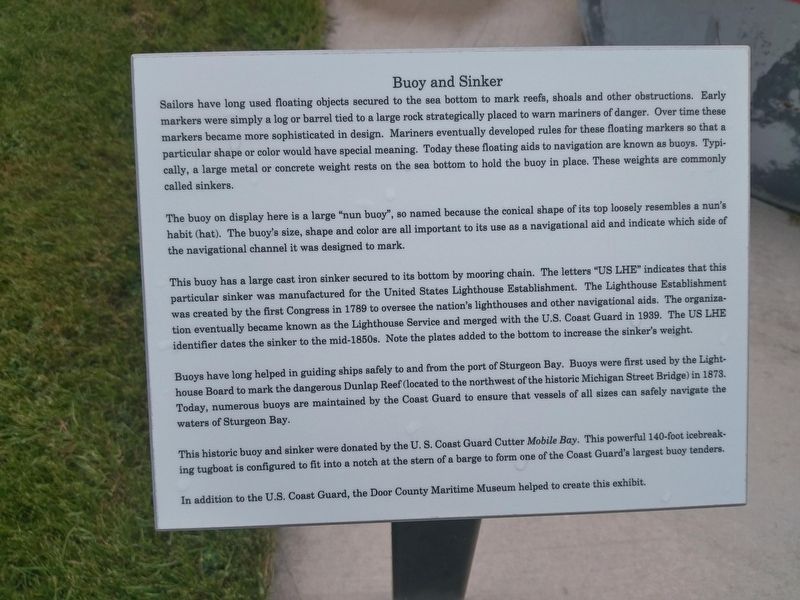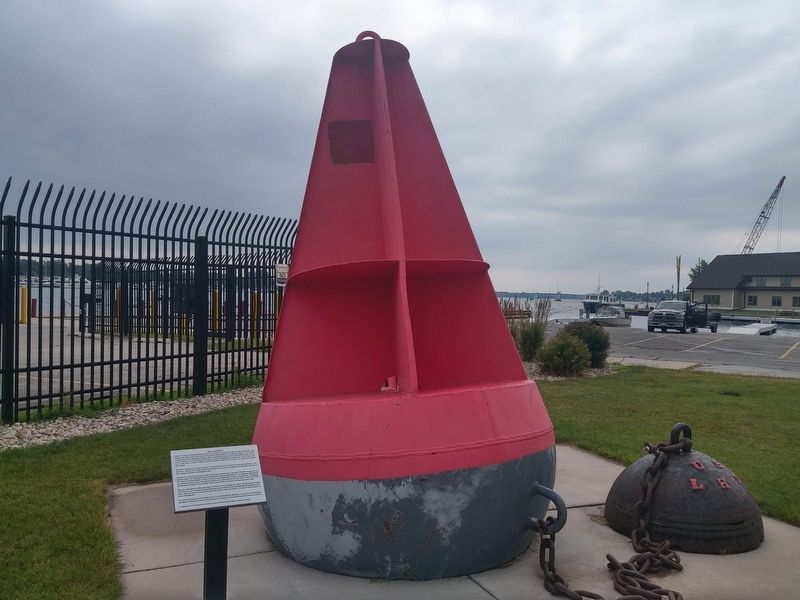Sturgeon Bay in Door County, Wisconsin — The American Midwest (Great Lakes)
Buoy and Sinker
The buoy on display here is a large "nun buoy", so named because the conical shape of its top loosely resembles a nun's habit (hat). The buoy's size, shape and color are all important to its use as a navigational aid and indicate which side of the navigational channel it was designed to mark.
This buoy has a large cast iron sinker secured to its bottom by mooring chain. The letters "US LHE" indicates that this particular sinker was manufactured for the United States Lighthouse Establishment. The Lighthouse Establishment was created by the first Congress in 1789 to oversee the nation's lighthouses and other navigational aids. The organization eventually became known as the Lighthouse Service and merged with the U.S. Coast Guard in 1939. The US LHE identifier dates the sinker to the mid-1850s. Note the plates added to the bottom to increase the sinker's weight.
Buoys have long helped in guiding ships safely to and from the port of Sturgeon Bay. Buoys were first used by the Lighthouse Board to mark the dangerous Dunlap Reef (located to the northwest of the historic Michigan Street Bridge) in 1873. Today, numerous buoys are maintained by the Coast Guard to ensure that vessels of all sizes can safely navigate the waters of Sturgeon Bay.
This historic buoy and sinker were donated by the U.S. Coast Guard Cutter Mobile Bay. This powerful 140-foot icebreaking tugboat is configured to fit into a notch at the stern of a barge to form one of the Coast Guard's largest buoy tenders.
In addition to the U.S. Coast Guard, the Door County Maritime Museum helped to create this exhibit.
Topics and series. This historical marker is listed in this topic list: Waterways & Vessels. In addition, it is included in the Lighthouses series list.
Location. 44° 49.717′ N, 87° 22.83′ W. Marker is in Sturgeon Bay, Wisconsin, in Door County. Marker can be reached from South Neenah Avenue. Touch for map. Marker is at or near this postal address: Sawyer Park, S Neenah Ave, Sturgeon Bay WI 54235, United States of America. Touch for directions.
Other nearby markers. At least 8 other markers are within walking distance of this marker. Sturgeon Bay's Waterfront History (here, next to this marker); a different marker also named Sturgeon Bay's Waterfront History (within shouting distance of this marker); The Fluke Anchor (within shouting distance of this marker); a different marker also named Sturgeon Bay's Waterfront History (within shouting distance of this marker); a different marker also named Sturgeon Bay's Waterfront History (about 300 feet away, measured in a direct line); Ship Propellers (about 300 feet away); a different marker also named Sturgeon Bay's Waterfront History (about 300 feet away); a different marker also named Sturgeon Bay's Waterfront History (about 400 feet away). Touch for a list and map of all markers in Sturgeon Bay.
Credits. This page was last revised on February 28, 2020. It was originally submitted on March 27, 2019, by Devon Polzar of Port Washington, Wisconsin. This page has been viewed 289 times since then and 29 times this year. Last updated on February 28, 2020, by Devon Polzar of Port Washington, Wisconsin. Photos: 1, 2. submitted on March 27, 2019, by Devon Polzar of Port Washington, Wisconsin. • Mark Hilton was the editor who published this page.

